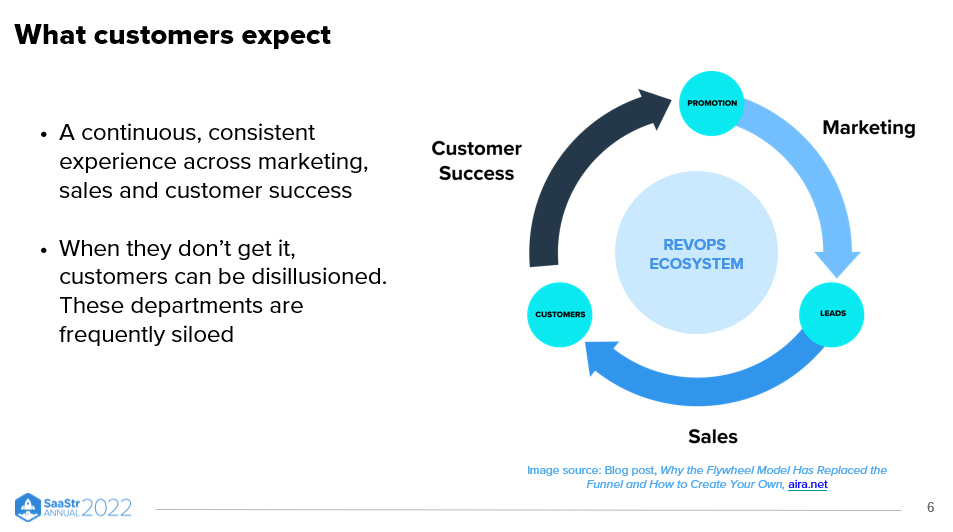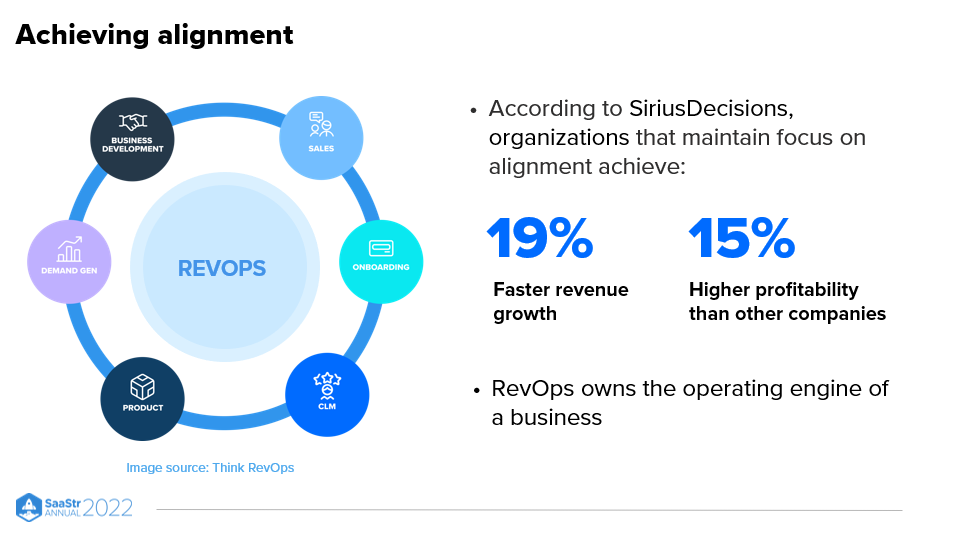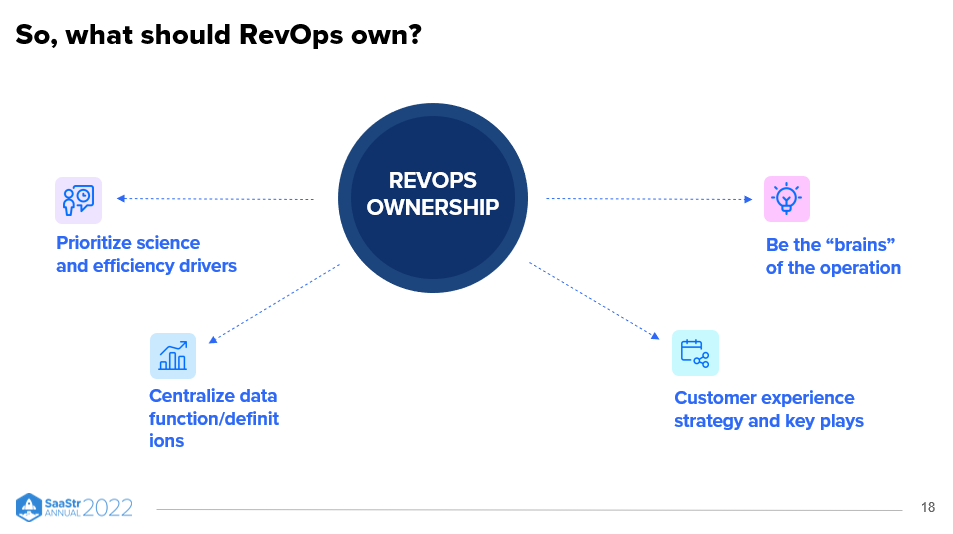In the current economic climate, investors weigh profitability over growth. There’s a trend toward transitioning from growth at all costs to paths to profitability. If you’re a go-to-market operator, you know this new imperative is not an either/or. Your enterprise must grow, and profitably. Kate Ahlering, CRO at Calendly, shares how revenue operations are every CRO’s secret weapon to revolutionizing enterprise sales growth.
Embracing revenue operations as buying cycles change
B2B buyer cycles continue to evolve, and more and more SaaS companies will embrace RevOps to drive profitability. How customers come into the sales funnel, when, where, and how they’re engaged are becoming increasingly digitalized. Take a look at a few figures that illustrate this truth:
- 80% of interactions between companies and buyers occur on digital channels
- 73% of digital natives are responsible for B2B decision-making at their companies
- 1 in 3 buyers is the sole decision-maker
- 1 in 2 buyers are the researchers who inform decisions
Product-led growth (PLG) is taking center stage in response to these changing buying patterns and flipped the sales funnel we’ve come to know. Now, the product is the funnel and an integral part of the customers’ evaluation experience. When you add a sales-led motion to PLG, RevOps can be the perfect complement.
The reason: it provides abundant data and can help drive insights while optimizing the entirety of the customer lifecycle from PLG to sales-led growth.

RevOps as a unifying force in go-to-market strategy
Companies’ go-to-market approach is becoming more complex as customer expectations change. Customers expect a continuous and consistent experience across the lifecycle, from marketing to sales and customer success.
Traditionally, each of these departments was siloed. Not anymore. Each channel, function, and team has different goals, metrics, and KPIs. When you’re looking at how you can marry product-led growth with a sales-led growth motion, revenue operations is the answer. It connects the dots, aligning sales, marketing, and customer service teams across the entire lifecycle while helping to continue providing an exceptional customer experience.
“Gartner predicts that 75% of the highest growth companies will need to deploy revenue operations by 2025.”
How to make RevOps work for you
Here’s a quick framework on how to deploy revenue operations:
1. Achieving alignment: Ensure there is agreement at an executive level that revenue operations is the driver of go-to-market productivity.
2. Building the engine: Focus on building resources, capability, and horsepower across various functions.
3. Measuring success: Fuel a framework for measuring success.
Let’s dive into each of these for more context.

1. Achieving alignment
Strong departmental dividing lines can make RevOps seem threatening, making cross-department alignment tricky. Achieving alignment requires a strategic and cultural shift that starts at the top. Sign an agreement with the executive team, where you align on a central set of goals, objectives, and KPIs. It’s also wise to develop a mutually agreed-upon definition of key stages in the buyer’s journey.
“Organizations that focus on alignment achieve 19% faster revenue growth and 15% higher profitability than other companies.”
Here are some questions you can ask yourself when working to achieve alignment:
- Have you established a clear definition of what a marketing-qualified lead (MQL) is?
- Do you have a service level agreement approved at the executive level for how fast sales should follow up on those MQLs?
- Do you have a consensus on what the ideal customer profile is?
- What should the scoring methodology be for companies with the highest propensity to buy from you and grow?
2. Building the engine
Next is building a team that meets your needs across various work areas. You need to resource multiple functions to make such a machine, starting with strategy and operations and then followed by core operations, enablement, and analytics.
- Strategy and planning: This group prepares and executes forward-looking key growth initiatives, from regular strategy assessment to thinking through the next moves and working on big bets.
- Core ops: The workhorses of a revenue operations team; they own processes and workflows, strategy execution, and compensation.
- Enablement: The primary responsibility is to bring the strategy to life with frontline teams, ensuring they are ready to go and have high-value conversations with customers.
- Analytics: The big brains of the operation, analytics drives powerful insights from the wealth of data to better understand past performance and make future predictions.
“RevOps is about defining, tracking, and managing the customer experience across the lifecycle to create great outcomes that lead to great customer growth.”

3. Measuring success
After driving alignment and building capability, you must also determine how you think about success inside your go-to-market. Measure value, volume, and velocity and check that each metric improves over time. Here’s a snapshot of what each of these metrics means:
Value: What’s the deal size? Pitch bigger and showcase the value of your product to increase the average deal size.
Volume: What’s the amount of leads, deals closed, and customers? Identify the best and most profitable sources to gather leads.
Velocity: How quickly can you close a deal? Optimize for velocity by focusing on sellers and processes.
Target to increase revenue productivity for every account executive and every CSM. This requires you to eliminate redundant work and ensure they’re spending more time with customers and less time on admin and other mindless tasks.
Finally, to drive continuous improvement, check in regularly. Don’t wait for quarterly business reviews.

RevOps can be a major driver of profitability
The traditional funnel has changed. Your product has to work and create an impact, and fast. RevOps can help you unlock enterprise value and drive science into the customer lifecycle via powerful data.
Your company needs to grow, and it needs to do so profitably. RevOps can be a secret weapon in this process. Here are a few final thoughts on how RevOps can do just that.
- Be the brains of your go-to-market operation by defining the right buyers and best journeys.
- Drive the customer experience strategy and prioritization of your frontline teams.
- Derive insights from aggregated product data to drive continuous improvement.
At the end of the day, it’s about providing an exceptional customer experience, getting to the moments that matter with your customers quickly, and then driving profitable growth back for your business.

